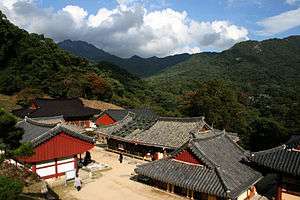Gayasan National Park
Gaya Mountain National Park (가야산) is in South Gyeongsang, South Korea. It is home to two of the famed 100 most beautiful mountains in South Korea and a popular weekend hiking destination.

Understand
History
Mt. Gaya is named after the Indian town of Gaya, where the Buddha achieved enlightenment. "Gaya" is Sanskrit for "cow", and indeed, the locals say that the peaks resemble a cow's head. This is one of the most remote parts of Korea and it survived Korea's wars largely unscathed.
Landscape
The landscape is primarily mountainous, but includes plains filled with reeds, flowers and much variety over the four seasons. It is home to eight mountains: Gaijisan, Goheonsan, Cheonhwangsan, Jaeyaksan, Ganwolsan, Sinbulsan, Yeongchuksan and Unmunsan.
Flora and fauna
Climate
The area is humid in summer, with highs over 30°C. In winter snow can fall on the mountain tops, although heavy hiking spikes are rarely needed. The national park is accessible all year.
Get in
By bus
The nearest town of importance is Daegu (60 km), easily reachable from most Korean town by KTX bullet train or bus. There are buses (1 hour) from Daegu's Seobu (west) Bus Terminal to Haeinsa every 20 minutes (₩6400).
There are also 3 connections per day from Daejeon Express Bus Terminal (₩13500) by way of Hamyang, and Geochang.
There are also connections from Gochang (₩3200), which can be reached from Gimcheon, permitting travel between Jikjisa temple near Gimcheon and Haein Sa.
The national park is accessible from Ulsan by catching a bus to the Eonyang bus terminal, the swapping to a bus headed for Seongnamsa, a Buddhist temple for nuns. Many of the trails originate from the temple, which is closest to Mt Gajisan.
By car
If you have your own car, you can also park at Baegundong, which has a park information center.
Fees and permits
Entrance to the park is free, but car parking costs ₩4000-6000/day.
Get around
Once in the park, the only way to get around is to hike. The most popular route is from Haeinsa up the Hongnyudong valley to Sangwangbong Peak and back again.
See
- Haeinsa Temple (해인사). One of the Korea's Three Jewel Temples and a UNESCO World Heritage Site, Haeinsa houses the Tripitaka Korea, a copy of Buddhist scripture carved onto 81,258 printing blocks.
Do
- Climb Sangwangbong Peak (1430m), about two hours from Haeinsa. The first 90 minutes is a gentle rise, but the last 30 minutes are more challenging.
- Climb Chulbulbong Peak (1433m)
Buy
Eat
Drink
Sleep
Lodging
There are some small hotels and yeogwan near both Haeinsa and Baegundong.
- Haeinjun Motel, ☎ +82 55-932-7378. Just across the bridge over from the bus station has a friendly owner, with rooms for ₩30,000. Cross the bridge and look for the red Motel symbol on the glass door after the restaurant.
Camping
Camping is allowed at designated campsites near Haeinsa and Baegundong for ₩3,000-6,000 per tent.
Backcountry
Stay safe
As with all hiking expeditions, make sure you take enough water and a first aid kit, especially as you are climbing mountains! Also take a hat and sunscreen, especially in summer when the temperatures can get quite high. Make sure you let someone know where you're going. As hiking is a national sport, you will see many Koreans hiking the trails, including the speedy grandmas (who will probably be faster than you).